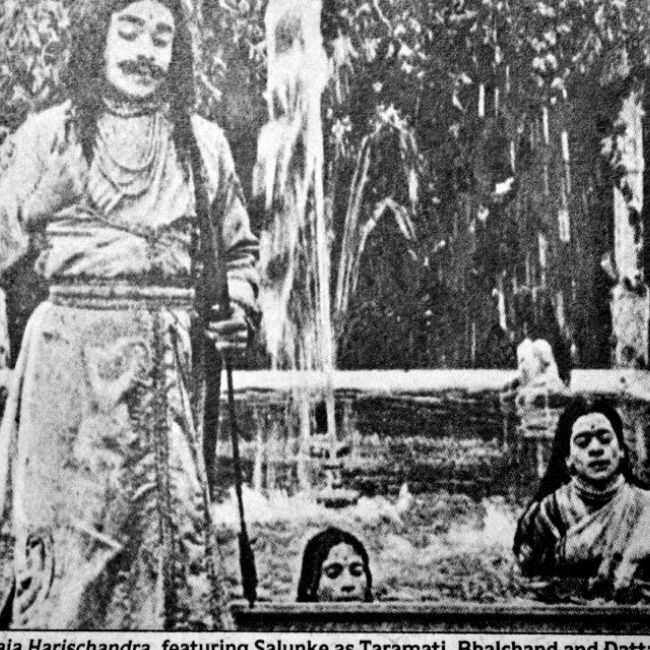
Raja Harishchandra – India’s first feature film
Recommended for Middle Grades
The Dawn of Indian Cinema: A Saga of Passion and Perseverance
Where shadows danced to the rhythm of dreams, and myths breathed life on a silver screen…
In the heart of a sweltering Bombay summer, a silent revolution unfolded. On April 21, 1913, amidst the hum of anticipation and the buzz of curious whispers, India’s first feature film, “Raja Harishchandra,” made its grand debut. This momentous occasion marked not just the birth of Indian cinema but also the ignition of a passion that would forever shape the nation’s cultural landscape.
In this evocative journey through time, we will delve into the remarkable story of “Raja Harishchandra,” the trailblazing creation of Dadasaheb Phalke, the revered Father of Indian Cinema. Through his lens, we will witness the confluence of mythology, artistry, and sheer determination that laid the foundation for the thriving film industry we know today.
The Visionary and His Dream
In the realm of dreams, a canvas awaits its artist…
Dadasaheb Phalke, a man of multifaceted talents, was not merely a filmmaker but an artist, a visionary, and a pioneer. With a background in photography, printing, and painting, he possessed a keen eye for detail and a deep appreciation for the power of visual storytelling.
It was during a screening of the 1910 film “The Life of Christ” that Phalke’s imagination was ignited. Mesmerized by the moving images, he envisioned a similar spectacle unfolding on Indian screens, one that would showcase the rich tapestry of Indian mythology and culture.
Thus began Phalke’s arduous journey to bring his dream to fruition. Faced with numerous challenges, from securing funding to procuring equipment and training actors, he persevered with unwavering determination. Like a sculptor chiseling away at a block of marble, Phalke meticulously crafted every aspect of his film, from the sets and costumes to the lighting and cinematography.
The Making of a Masterpiece
Where imagination paints reality with vibrant hues…
The production of “Raja Harishchandra” took place in a modest bungalow called Mathura Bhawan in Bombay, a far cry from the sprawling studios of today. Yet, within those walls, Phalke and his dedicated team created magic.
The film, based on the epic tale of King Harishchandra’s unwavering commitment to truth and righteousness, resonated deeply with Indian audiences. Phalke’s meticulous attention to detail brought the mythological characters to life, their emotions conveyed through subtle gestures and expressive eyes.
Despite being a silent film, “Raja Harishchandra” captivated viewers with its powerful storytelling and visual grandeur. The absence of dialogue allowed the audience to immerse themselves fully in the narrative, their imaginations filling in the gaps with their own interpretations.
A Legacy Unveiled
As the curtain falls, a legacy takes flight…
The release of “Raja Harishchandra” was met with resounding success, drawing crowds from all walks of life. The film’s popularity transcended geographical boundaries, and it was even screened in London in 1914, introducing the world to the nascent Indian film industry.
Dadasaheb Phalke’s contribution to Indian cinema cannot be overstated. He not only directed the first feature film but also pioneered various filmmaking techniques and marketing strategies. His passion and dedication laid the groundwork for the thriving industry that exists today.
“Raja Harishchandra” ignited a spark in the hearts of countless Indians, inspiring them to pursue careers in filmmaking. It marked the beginning of a cinematic journey that would capture the essence of India’s diverse culture, its joys, sorrows, and aspirations.
Conclusion
The story of “Raja Harishchandra” is a testament to the power of dreams and the indomitable spirit of human creativity. It reminds us that even in the face of adversity, with unwavering passion and perseverance, we can achieve the impossible.
As we reflect on this remarkable tale, let us celebrate the legacy of Dadasaheb Phalke and the countless artists who have followed in his footsteps. May their stories continue to inspire generations to come, reminding us that the magic of cinema lies not just in the moving images but in the dreams they ignite within us.
For in the realm of dreams, anything is possible…
Watch a video
The Legend. The Legacy. The First.
Curious Times is a leading newspaper and website for kids. We publish daily global news aligned to your learning levels (also as per NEP 2020): Foundational, Preparatory (Primary), Middle and Senior. So, check out the News tab for this. We bring kids’ favourite Curious Times Weekly newspaper every weekend with top news, feature stories and kids’ contributions.
Curious Times News Program for Schools for FREE. Over 5,000 schools and teachers from all over the world have joined our programme so that students and teachers can get FREE Educative Newspaper. Here, kids can take part in world events and win prizes and certificates for free through their schools.
The following social media platforms allow you to communicate with us: Instagram.
0 (Please login to give a Curious Clap to your friend.)
